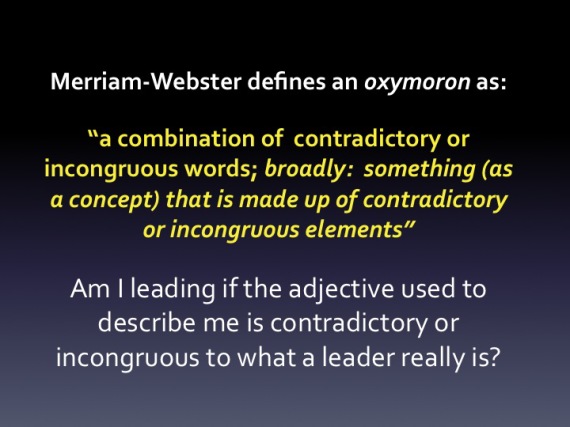The Passive Leader- Oxymoronic Leadership Yarn #4
The meeting ground to a halt as soon as Sean spoke. “Let’s not get ahead of ourselves.”
This all too familiar phrase had killed many great ideas within Sean’s team. But, Sean’s people had hope. A recent restructuring placed a new leader between the team and Sean. Maybe the new guy could get things done.
Martin was an up and comer in the company. He had turned around an underperforming office in Omaha. Now he was in a much bigger market- Dallas. This was a big step for such a young leader.
The new structure made Martin in charge of day to day operations in the Dallas office. Sean had ultimate veto authority because of his experience. But, his role was to focus on big picture, strategic issues while Martin worked on the day to day.
Three Meetings and A Funeral
Meeting #1
Sean was happy to see Martin. He knew Martin had done great things in Omaha and felt he would be a breath of fresh air in what had become a stale office.
After some pleasantries, Martin asked what Sean wanted him to tackle first.
“Lets not get ahead of ourselves here Martin. Why don’t you spend some time getting to know the people in our office. Speak to them. Watch what they do and how they do it. Learn their personalities.”
Sean told Martin to spend a week digging into each of the three departments in the Dallas office. Even though they were the same departments as Omaha, Sean assured Martin that things were different in Dallas.
Martin left the meeting a little deflated, but willing to follow Sean’s lead. He dove into his work and quickly became familiar with each department’s operations and personnel.
Meeting #2
Sean told him to take three weeks to do what Martin felt he could have done in one. But, after three weeks, he was excited to finally get to work. He walked into Sean’s office with a pad full of notes and some ideas he knew would quickly improve operations in each department.
“Slow down here Martin. Things have been going along pretty well for a long time. It may be easy to make changes in an office like Omaha, but in an office as big as Dallas, things need to move slower.
Change is good if it is done when change is needed. Change for change sake only creates more work and uncertainty for everyone. Whenever we’ve been mandated to make changes, we miss that quarter’s numbers.
I know I have been given authority to make some changes, but let’s not get ahead of ourselves. Let me take your suggestions and run them up the flagpole to corporate.”
Martin’s last page of notes was about a personnel issue concerning Sean’s former assistant. She was in her third department in the last three years. In each department, her work was sub-par and her attitude was worse. Unfortunately, Sean’s reviews gave her satisfactory ratings and average raises over the last 3 years.
“I’d be happy for you to handle that one Martin. Honestly, with all the documentation that is required to get rid of someone these days, I just haven’t had the energy to do it. HR will want you to have at least three documented issues in the next six months before we can begin the process of releasing her.”
Within three months, Martin had taken care of the personnel problem and hired a young aggressive assistant. He felt good about the impact she would have, but he knew he was capable of doing a lot more.
Meeting #3:
After six months, Martin was tired of treading water. He set up a formal meeting with Sean to review the progress of the Dallas office over the last two quarters. Though Martin kept his emotions under control, he was very forthright with his frustrations.
“Sean, I was brought in here to help. I was brought in here to make changes like I did in Omaha. But I feel like the changes I am trying to make are not what you want. With each idea I bring to you, you have a reason to put it off.
Honestly, the only thing you have allowed me to change around here was a secretary. This office is falling behind. We are not bringing in enough new customers. The sales people are content with maintaining their current customers. But those customers are in industries that are in decline. A cliff is coming and we need to make changes!”
“Okay Martin. I hear you. Why don’t you sit down with the sales group and come up with some ideas we can implement at our level. I heard a new marketing strategy may be coming from corporate soon. Just be sure what you come up with won’t be too radical. We may have to make changes that corporate mandates in the next six months. That would just be too much chaos. Some things need to continue “as is”.”
“What about the other areas I detailed for you in our previous meetings, Sean?”
“Come on Martin. Let’s take this slow and see if your meeting with the sales team bears some fruit. Making changes in every department, all at once, will be too big a disruption in our current operations. “
A Funeral:
As Martin moved into Sean’s office, he looked through the Sean’s archived emails. He found emails from corporate reminding Sean that he had the authority to make the changes necessary to jump start the Dallas office.
Shaking his head, Martin looked up and saw two of his department heads at his door.
“Martin? If you have a moment, could we run a couple of ideas by you?”
With a smile, Martin said, “Guys, if you think they will work and they are within regulations, have at it!”
With a fist bump, the two department leaders turned around and got to work.
The Bottom Line:
The leader who does nothing, will not make a stand, and waits for others to make decisions for them is an OxyMORONic Leader.
People want to follow leaders who have energy. People want to follow leaders who want to move forward. People want to follow leaders who will take decisive action.
The bottom line for The Passive Leader is personal comfort and conflict avoidance. Those two traits are not part of a real leader.
The Indecisive Leader and the Risk Averse Leader have different issues. I will explore them in my next two Oxymoronic Leadership Yarns.
Question:
When has passivity prevented you or one of your leaders from making an important decision?

